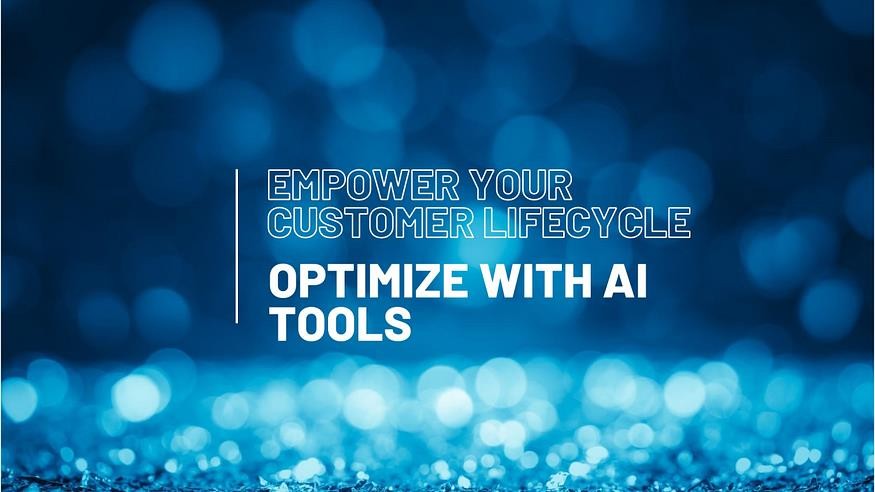In today’s dynamic business landscape, optimizing customer related functions has become paramount. The advent of Artificial Intelligence (AI) has revolutionized how companies handle customer-related functions such as Customer Engagement (CE), Customer Experience (CX), Customer Success (CS), and Customer Relationship Management (CRM). These AI tools are no longer futuristic fantasies, they are real, effective solutions that businesses are increasingly adopting to stay competitive and thrive in the fast moving marketplace. Let’s delve into the diverse array of AI tools available in the market today
and their roles in different customer-related functions:
Chatbots & Virtual Assistants: AI-powered chatbots and virtual assistants are at the forefront of customer engagement. These intelligent systems use Natural Language Processing (NLP) to understand and respond to customer queries in real-time, providing personalized recommendations, guiding users through processes, and automating routine tasks. They operate round the clock, offering instant support and driving efficiency in customer interactions.
Sentiment Analysis & Social Listening: Sentiment analysis tools leverage AI algorithms to analyze customer feedback, social media conversations, and online reviews. By gauging sentiment, businesses can understand customer perceptions, identify emerging trends, and promptly address issues or capitalize on positive feedback. Social listening tools further enhance brand monitoring and reputation management by tracking mentions, sentiments, and engagement levels across various platforms.
Automated Customer Support & Self-Service: AI-driven automated customer support systems enable self-service options for customers. These tools can handle common inquiries, troubleshoot technical issues, and provide relevant information without human intervention. By empowering customers to find solutions independently, businesses reduce support costs, improve response times, and enhance overall satisfaction. Helpdesk, Ticketing & Automated Communications: AI-powered helpdesk and ticketing systems streamline customer support workflows. They automate ticket creation, prioritize inquiries based on urgency, and route tickets to the appropriate teams or agents. Automated communications tools leverage AI to send personalized messages, notifications, and updates, ensuring timely and relevant communication with customers throughout their journey.
CRM Platforms: AI-driven CRM platforms revolutionize customer relationship management by centralizing customer data, analyzing interactions, and predicting future behaviors. These platforms segment customers, personalize marketing campaigns, track sales pipelines, and provide actionable insights to drive revenue growth and foster long-term relationships.
Below is a sample of AI tools for various functions related to Customer Lifecycle Optimization.

Customer Success Management Platforms: Customer success management platforms leverage AI to proactively monitor customer health, identify at-risk accounts, and deliver personalized interventions. These tools facilitate onboarding, provide product usage guidance, and track customer satisfaction metrics, ensuring that customers derive maximum value from their investments and remain loyal advocates.
Customer Health Monitoring, Insight & Analytics: AI-powered analytics tools delve deep into customer data to uncover meaningful insights and trends. They track key metrics such as customer churn rates, lifetime value, engagement levels, and satisfaction scores, enabling businesses to make data-driven decisions, optimize strategies, and continuously improve the customer experience.
Voice Recognition & NLP: Voice recognition technology and Natural Language Processing (NLP) empower AI systems to understand and respond to spoken commands and queries. These capabilities are integrated into virtual assistants, customer service channels, and IoT devices, offering seamless and intuitive interactions for customers across various touchpoints.
Personalization & Recommendation Engines: AI-driven recommendation engines analyze customer preferences, behavior patterns, and historical data to deliver personalized recommendations, product suggestions, and content recommendations. By tailoring experiences based on individual preferences, businesses enhance engagement, drive conversions, and build stronger customer relationships.
Live Chat & Messaging Platforms: AI-powered live chat and messaging platforms enable real-time communication between businesses and customers. These platforms offer personalized assistance, answer queries, resolve issues, and facilitate transactions, enhancing customer satisfaction and driving conversions through interactive and convenient channels.
E-Commerce & Retail Engagement Tools: AI tools in e-commerce and retail focus on optimizing the customer journey, from personalized product recommendations and targeted promotions to seamless checkout experiences and post-purchase support. These tools leverage AI algorithms to analyze shopper behavior, optimize inventory management, and enhance the overall shopping experience across online and offline channels.
Usage Analytics & Product Adoption: AI-driven usage analytics tools track how customers interact with products and services, identify usage patterns, and measure product adoption rates. By understanding how customers engage with offerings, businesses can optimize features, improve usability, and tailor support resources to drive adoption and customer satisfaction.
AI tools have become indispensable assets for businesses seeking to optimize customer relations across various functions. From intelligent chatbots and sentiment analysis to personalized recommendations and usage analytics, AI-driven solutions empower businesses to deliver seamless, positive experiences and reduce churn, leading to increased revenue, profitability and ROI. As AI continues to evolve, its potential to transform customer lifecycle optimization will continue to expand, enabling a sustainable win-win relationship between the customer and provider.

